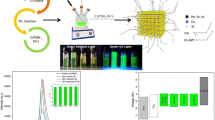Abstract
Boron-contained compounds are one kind of new energetic materials, and have been synthesized successfully lately. However, the effects of introduced boron atoms into the energetic system are unclear. In this work, using the known insensitive energy crystal 2,6-diamino-3,5-dinitropyrazine-l-oxide (LLM-105) as the model compound, boron doping effects on its crystal structure, band gap and structure, intermolecular contacts, sensitivity, elastic property, optical absorption behavior, and dielectric function were studied by the first principles calculations and Hirshfeld surface analysis. One B atom was doped at four different doping sites in the ring (two kinds of nitrogen N1/N2 and carbon atoms C3/C4), respectively, and formed four new crystals LLM-105-B1/B2/B3/B4. The results showed that the B atom and its doping site both make great influence on the structure and properties. The B doping obviously decreased the band gap and weakened the strength of intermolecular contacts, giving rise to higher sensitivity and worse safety. Especially for LLM-105-B4 which has a 0 eV value of band gap, the doped B atom made great contributions to the density of states around the Fermi level, leading to the suddenly move down of lowest unoccupied molecular orbital and directly link of total density of states at the Fermi level. Doping the B atom at the site C3 improved the ductility and plasticity of LLM-105, while LLM-105-B2 was found to be the most brittle and anisotropic crystal. Doping B atoms at sites N2 and C4 increased the absorption to green, orange, and red lights, while the absorption strength to the infrared light was enhanced in most cases. The dielectric constant and polarity were significantly increased by doping boron atoms at sites C3 and C4.










Similar content being viewed by others
References
Gilardi RD, Butcher RJ (2011) Acta Cryst E 57:657–658
Tang YX, He CL, Imler GH, Parrish DA, Shreeve JM (2018) J Mater Chem A 6:8382–8387
Kumar D, Tang YX, He CL, Imler GH, Parrish DA, Shreeve JM (2018) Eur J Chem 24:17220–17224
He CL, Gao HH, Imler GH, Parrish DA, Shreeve JM (2018) J Mater Chem A 6:9391–9396
Zhang WQ, Zhang JH, Deng MC, Qi XJ, Nie FD, Zhang QH (2017) Nat Commun 8:181
Wang Y, Liu YJ, Song SW, Yang ZJ, Qi XJ, Wang KC, Liu Y, Zhang QH, Tian Y (2018) Nat Commun 9:2444
Wang Q, Shao YL, Lu M (2019) Chem Commun 55:6062–6065
Bélanger-Chabot G, Rahm M, Haiges R, Christe KO (2015) Angew Chem Int Ed 127:11896–11900
Shitov OP, Tartakovsky VA, Golovanov IS, Sukhorukov AY, Loffe SL (2017) Chem Asian J 12:2237–2244
Wu WJ, Chi WJ, Li QS, Ji JN, Li ZS (2017) J Phys Org Chem 30:3699
Wu WJ, Chi WJ, Li QS, Ji JN, Li ZS (2017) J Mol Model 23:191
Zeng X, Li N, Jiao QJ (2018) RSC Adv 8:14654–14462
Hamann DR, Schlüter M, Chiang C (1979) Phys Rev Lett 43:1494
Grimme S (2006) J Comput Chem 27:1787–1799
Tkatchenko A, Scheffler M (2009) Phys Rev Lett 102:073005
Krukau AV, Vydrov OA, Izmaylov AF, Scuseria GE (2006) J Chem Phys 125:224106
Clark SJ, Segall MD, Pickard CJ, Hasnip PJ, Probert MI, Refson K (2005) Payne MC. Z Krist-Cryst Mater 220:567–570
Wolff S, Grimwood D, Mckinnon J, Turner M, Jayatilaka D, Spackman M (2012) Crystalexplorer (version 3.0). University of Western Australia
Crowley JM, Tahir-Kheli J, Goddard WA (2016) J Phys Chem Lett 7:1198–1203
Ramasubramaniam A, Naveh D, Towe E (2011) Phys Rev B 84:205325
Patra A, Jana S, Myneni H, Samal P (2019) Phys Chem Chem Phys 21:19639–19650
Guo SY, Zhu Z, Hu XM, Zhou WH, Song XF, Zhang SL, Zhang K, Zeng HB (2018) Nanoscale 10:8397–8403
Wang Y, Huang CB, Li D, Li P, Yu JY, Zhang YZ, Xu JR (2019) J Phys Condens Matter 31:285501
Wang Y, Huang CB, Li D, Huang F, Zhang XY, Huang K, Xu JR (2019) J Phys Condens Matter 31:465502
Zhu WH, Xiao HM (2010) Struct Chem 21:657–665
Ma Y, Meng LY, Li HZ, Zhang CY (2017) CrystEngComm 19:3145–3155
Wu Q, Li MQ, Hu QN, Zhang ZW, Zhu WH (2020) J Mater Sci 55:237–249
Tian BB, Xiong Y, Chen LZ, Zhang CY (2018) CrystEngComm 20:837–848
Baxter AF, Martin I, Christe KO, Haiges R (2018) J Am Chem Soc 140:15089–15098
Born M, Huang K (1982) Dynamical theory and experiment I. Springer-Verlag, Berlin
Stavrou E, Manaa MR, Zaug JM, Kuo IFW, Pagoria PF, Kalkan B, Crowhurst JC, Armstrong MR (2015) J Chem Phys 143:144506
Zong HH, Zhang LL, Zhang WB, Jiang SL, Yu Y, Chen J (2017) J Mol Model 23:275
Saha S, Sinha TP (2006) Phys Rev B 62:8828
Zhu WH, Xiao JJ, Xiao HM (2006) J Phys Chem B 110:9856–9862
Funding
The present work was supported by the Natural Science Foundation of Jiangsu (BK20170761, BK20160774), the Natural Science Foundation of Nanjing Institute of Technology (JCYJ201806, CKJA201603), the Jiangsu Key Laboratory Opening Project of Advanced Structural Materials and Application Technology (ASMA201707), Outstanding Scientific and Technological Innovation Team in Colleges and Universities of Jiangsu Province, and Jiangsu Overseas Visiting Scholar Program for University Prominent Young & Middle-aged Teachers and Presidents.
Author information
Authors and Affiliations
Corresponding author
Ethics declarations
Conflict of interest
The authors declare that they have no conflict of interest.
Additional information
Publisher’s note
Springer Nature remains neutral with regard to jurisdictional claims in published maps and institutional affiliations.
Rights and permissions
About this article
Cite this article
Wu, Q., Li, M., Hu, Q. et al. Effects of boron doping on structural, electronic, elastic, and optical properties of energetic crystal 2,6-diamino-3,5-dinitropyrazine-1-oxide: a theoretical study using the first principles calculation and Hirshfeld surface analysis. J Mol Model 26, 41 (2020). https://doi.org/10.1007/s00894-020-4310-2
Received:
Accepted:
Published:
DOI: https://doi.org/10.1007/s00894-020-4310-2




